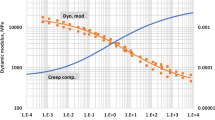Summary
The migration of water within fresh concrete to produce the phenomenon known as “water gain” appears to have received far too little attention, particularly as regards failure theories which assume that concrete exhibits isotropic behaviour. It is shown that concrete is anisotropic when subjected to either tensile or compressive stresses. Reliable comparisons of tension and compression test results must therefore relate the direction of testing the specimens to the vertical direction at casting. The design of cast in-situ columns, for example, based on normal cube test results can be particularly unsafe. The effects of anisotropic behaviour upon failure envelopes for biaxial states of stress are also considered.
Résumé
La migration d'eau à travers le béton frais, qui produit le phénomène du ressuage, ne parait pas avoir suscité une attention suffisante, particulièrement en ce qui concerne les théories de la rupture qui dépendent de l'hypothèse d'un comportement isotropique du béton. On montre ici que le béton est anisotropique lorsqu'il est soumis à une contrainte en traction ou en compression. Une étude comparative sérieuse des résultats d'essais en traction et en compression doit par conséquent relier la direction de l'essai des éprouvettes à la direction verticale au moment du coulage. Le calcul de poteaux coulés in-situ d'après les résultats de l'essai normal sur cube peut, par exemple, être particulièrement inadéquat. On considère aussi les effets du comportement anisotropique sur les enveloppes de rupture pour la condition de contrainte biaxiale.
Similar content being viewed by others
References
Hughes B. P., Ash J. E.—Water gain and its effects on concrete. Concrete, vol. 3, no 12. december, 1969 pp. 494–496.
Hughes B. P., Ash J. E.—The effect of water gain on the behaviour of concrete in tension, torsion and compression. Technical Paper PCS 54. The Concrete Society.
Ash J. E.—The properties of concrete. Ph. D. Thesis University of Birmingham June, 1967, pp. 215–252.
Hughes B. P., Chapman G. P.—Direct tensile test for concrete using modern adhesives. Rilem Bulletin, No. 26, March 1965, pp. 77–80.
Newman K.—Criteria for the behaviour of plain concrete under complex states of stress. The Structure of Concrete. Proceedings of an International Conferene C. and C.A. 1965, pp. 255–274.
Vile G. W. D.—The strength of concreter under short term static biaxial stress. The Structure of Concrete. Proceedings of an International Conference C. and C.A., 1965, pp. 275–287.
Comité Européen du Béton.Recommendations of the C.E.B. for an international code of practice. Part I. Principles and Recommendations. Translation by Cement and Concrete Association, London, 1963, p. 72.
British Standard Code of Practice for the Structural Use of Concrete. (Draft for Comment). British Standards Institution, London, 1969.
Rights and permissions
About this article
Cite this article
Hughes, B.P., Ash, J.E. Anisotropy and failure criteria for concrete. Mat. Constr. 3, 371–374 (1970). https://doi.org/10.1007/BF02478760
Issue Date:
DOI: https://doi.org/10.1007/BF02478760




